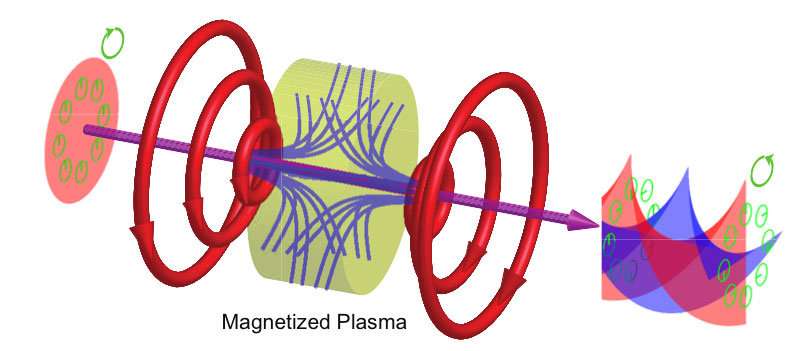Magnetized plasmas that twist light can produce powerful microscopes and more

To get the extremely high-resolution images vital to study new materials, microbes, and more, scientists often build microscopes based on optical vortices. Forming these tiny tornadoes of light is done using quartz or liquid crystals. However, using conventional materials for microscopes has its limits. As the power of the optical vortex increases, the material literally burns up and is destroyed. To produce the optical vortices, researchers needed a better approach. They devised a way to make optical vortices with 1000 times more power than previous methods. Their design uses strong, nonuniform magnetic fields to control plasmas, or ionized gases, to create the vortices.
The new approach, known as a plasma q-plate, will revolutionize sources for generating optical vortices. The work will impact a broad range of applications. For example, the new approach could lead to super-resolution microscopy. It could increase the bandwidth of optical fiber and millimeter-wave wireless communications. Also, the new approach could benefit quantum communication with unbreakable encryption.
Light is a travelling wave of electric and magnetic fields. We all know that when a stone is thrown into a pond, the wavefronts form concentric circles. For a laser beam of light moving uniformly in one direction, the wavefronts form parallel sheets with a centrally peaked intensity profile. There exists another special type of light beam, called an optical vortex, whose wavefronts twist and rotate as it passes through space. An optical vortex has rotating wavefronts and a hollow intensity profile. This vortex can trap, rotate, and "control" microscopic particles or droplets, thereby functioning as an "optical spanner" that enhances the control flexibility of the "optical tweezers" that can trap particles. Development of this method for cooling and trapping particles won the 1997 Nobel Prize in Physics. Super-resolution microscopes, with resolutions smaller even than the diffraction limit of light, can also be built using optical vortices (see 2014 Nobel Prize in Chemistry).
Low intensity optical vortices can be formed using birefringent material media, such as quartz or liquid crystal, which split light into parallel and perpendicular "polarizations." However, using conventional material media for the microscopes has its limitations. As the intensity (power) of the optical vortex increases, the material literally burns up. To produce high-power optical vortices, a team employed a plasma medium. The task of creating the required structure in plasma is challenging because plasma is inherently unstructured. The team's approach circumvents the difficulty of creating structure by introducing anisotropy through a magnetic field. The team determined that a non-twisting laser beam, after propagating through magnetized plasma, could be converted into an optical vortex. The magnetized plasmas can manipulate the laser wavefront and directly convert a high-intensity Gaussian beam, say at a terahertz, into a twisted beam with high efficiency.
More information: Kenan Qu et al. Plasma q -plate for generation and manipulation of intense optical vortices, Physical Review E (2017). DOI: 10.1103/PhysRevE.96.053207
Journal information: Physical Review E
Provided by US Department of Energy




















